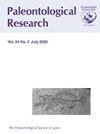Early Plotopteridae Specimens (Aves) from the Itanoura and Kakinoura Formations (Latest Eocene to Early Oligocene), Saikai, Nagasaki Prefecture, Western Japan
IF 0.6
4区 地球科学
Q3 PALEONTOLOGY
引用次数: 2
Abstract
Abstract. Plotopterids, commonly known as “penguin-like birds”, are wing-propelled diving birds known from the latest Eocene to middle Miocene in the eastern and western Pacific Rim. Here, we describe two new specimens of the family Plotopteridae, a right femur from the Itanoura Formation (latest Eocene to earliest Oligocene), and a distal half of a right tibiotarsus from the Kakinoura Formation (early Oligocene), both at the lower part of the Nishisonogi Group, Saikai City, Nagasaki Prefecture, Kyushu, southwestern Japan. The femur is slightly younger than or potentially as old as the earliest plotopterid known from Japan and the U.S.A. CT scanning revealed that it has a dense cortical bone, justifying its taxonomic assignment to the family Plotopteridae. It resembles the femur of Olympidytes, which was previously considered endemic to North America, in its femoral neck, well developed trochanter femoris, and straight facies articularis antitrochanterica, but is not assignable to any known genus. The tibiotarsus resembles that of Olympidytes in the presence of a well-developed trochlea catilaginis tibialis, a large embossment lateral to the pons supratendineus, and a deep incisura intercondylaris, and therefore referable to Olympidytes. The possibility of hindlimb-propelled diving in the family Plotopteidae was also discussed. These new specimens suggest the early diversity of the family in Japan was higher than previously thought.日本西部长崎县赛开市Itanoura和Kakinoura组(最新始新世至渐新世早期)的早期Plotopteridae标本(Aves)
摘要Plotopterids,通常被称为“企鹅状鸟类”,是一种翅膀推进的潜水鸟类,从始新世晚期到中新世中期,生活在环太平洋东部和西部。在这里,我们描述了两个新的Plotopteridae科标本,一个来自Itanoura组(始新世晚期至渐新世早期)的右股骨,和一个来自Kakinoura组(渐新世早期)的右胫跗骨的远端一半,它们都是在日本西南部九州长崎县西海市西野木群的下部。该股骨比日本和美国已知的最早的plotopterid稍微年轻,或者可能和它一样古老。CT扫描显示,它有一个致密的皮质骨,证明了它在分类上属于Plotopteridae家族。它的股骨颈、发育良好的股骨粗转子和直相的反股骨粗关节与以前被认为是北美特有的奥林匹亚的股骨相似,但不能归属于任何已知属。胫跗骨与奥林匹克细胞相似,存在发育良好的胫骨软骨滑车,桥腱上肌外侧有一个大的凸起,髁间有一个深的门牙,因此与奥林匹克细胞有关。还讨论了龙科恐龙后肢推进潜水的可能性。这些新发现的标本表明,该家族在日本的早期多样性比之前认为的要高。
本文章由计算机程序翻译,如有差异,请以英文原文为准。
求助全文
约1分钟内获得全文
求助全文
来源期刊

Paleontological Research
PALEONTOLOGY-
CiteScore
1.60
自引率
0.00%
发文量
47
审稿时长
>12 weeks
期刊介绍:
Paleonotological Research (PR) is a quarterly, peer-reviewed international journal, which focuses on original contributions primarily in the area of paleontology but also covering a wide range of allied sciences. It has been published since 1997 as a successor to the former journal Transactions and Proceedings of the Palaeontological Society of Japan. The emphasis of contributions will include global and local perspectives, and contents can cover all ages (Precambrian to the Quaternary, including the present time).
 求助内容:
求助内容: 应助结果提醒方式:
应助结果提醒方式:


